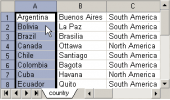MS SQL Maestro online Help
| Prev | Return to chapter overview | Next |
CLR UDT Editor
CLR UDTs can be edited within CLR UDT Editor. In order to run the editor you should either
| • | select the CLR UDT for editing in the explorer tree (type the first letters of the CLR UDT name for quick search); |
| • | select the Edit CLR UDT ... item from the popup menu |
or
| • | open the schema in Schema Editor and the CLR UDTs tab there; |
| • | select the CLR UDT to edit; |
| • | press the Enter key or select the Edit CLR UDT item from the popup menu (alternatively, you may use the corresponding link of the Navigation Bar). |
You can change the name of the CLR UDT using the Rename CLR UDT dialog. To open the dialog you should either
| • | select the CLR UDT to rename in the explorer tree; |
| • | select the Rename CLR UDT item from the popup menu |
or
| • | open the schema in Schema Editor and the CLR UDTs tab there; |
| • | select the CLR UDT to rename; |
| • | select the Rename CLR UDT item from the popup menu (alternatively, you may use the corresponding link of the Navigation Bar). |
The basic principles of Object Editors in MS SQL Maestro are explained in a separate topic. Below you will find a description of editor tabs that are unique for the current object.
CLR UDF Properties
Name
Specify the CLR UDT name.
Owner
Select the owner of the CLR UDT.
Comment
Specify a comment to the CLR UDT.
Assembly, Class
Defines the method of a .NET Framework assembly for a CLR stored function to reference. Class must be a valid SQL Server identifier and must exist as a class in the Assembly.
See also: Create UDT Wizard
| Prev | Return to chapter overview | Next |





 Download
Download Buy
Buy
